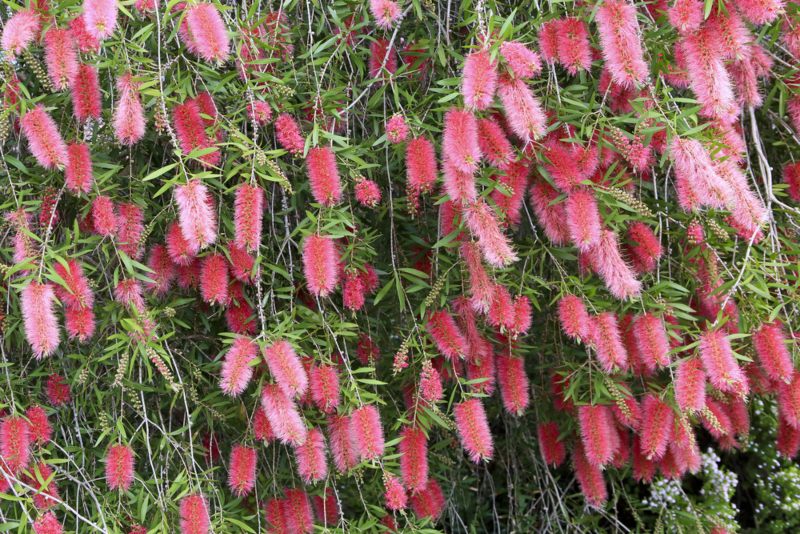Bottlebrush (Callistemon spp.) includes over 50 species of perennial shrubs that produce striking brush-shaped flowers in shades of red and crimson, but some varieties produce yellow or white blooms. Most are cold hardy in USDA plant hardiness zones 8b to 11 with a few varieties that are hardy in zones 4 through 9. Bottlebrush shrubs range in height from 2 feet to 15 feet and typically bloom in late spring or summer. These long-lasting blooms add color and texture to the flowerbed.
Light and Temperature Requirements
Bottlebrush shrubs prefer full sun but will grow in less light. But beware. When grown in a shady location your bottlebrush shrubs will produce fewer and smaller blooms and may not bloom at all.
Choose a location that gets 6 to 8 hours of direct sunlight a day. The hours of sunlight do not need to be consecutive but should add up to at least 6 hours. A few hours of bright morning light, some noontime shade and a few hours of sunlight in the afternoon should keep your bottlebrush shrub happy and healthy.
Bottlebrush shrubs can withstand high temperatures but prefer low humidity.
Watering
Established bottlebrush shrubs are drought tolerant and typically do not require supplemental watering except in extreme dry spells. Check the top 4 inches of soil. If it is dry, your bottlebrush shrubs need watering.
Young or newly planted bottlebrush shrubs need soil that is slightly moist. Water them when the soil is dry 1 inch below the surface. It is best to water them deeply to saturate the soil to the root level. This encourages strong root formation.
Soil & Fertilizing
Bottlebrush shrubs prefer humus-rich, well-drained soil with a pH between 5.6 and 7.5. Prepare the soil by adding a 3- to 4-inch layer of organic matter, such as peat moss, compost or well-rotted manure, and working it into the existing soil. This will improve aeration and help promote good drainage. If your soil is alkaline, peat moss may help lower the pH as well.
Apply an all-purpose balanced fertilizer in the spring to promote healthy growth. Some prefer to apply a high phosphorus fertilizer 2 to 3 weeks before blooming. Phosphorus promotes healthy blooms.

Deadheading and Pruning
Deadheading old blooms on your bottlebrush shrub improves its appearance and may force the shrub to produce a new flush of blooms as well. Cut the faded blooms below the bottom of the bloom leaving as much stem as possible.
Pruning your bottlebrush shrub is often necessary to control the size and shape. While light pruning can be done at any time, pruning to control the height should be done in early spring by cutting back the tops of branches.
Major pruning should be done shortly after the first blooming cycle. This is the time to remove any dead wood on your bottlebrush shrub, trim away any branches that cross over the center of the shrub and remove suckers around the base of the shrub.
Propagation
Bottlebrush is best propagated via wood cutting taken from the shrub in early summer before the wood matures.
- Take 6-inch cuttings from the ends of branches.
- Remove the leaves on the bottom of the cutting, leaving 2 or 3 leaves on the growing tip.
- Dip the ends of the cuttings in rooting powder and shake to remove the excess powder.
- Insert the end into pots filled with a soilless potting mixture.
- Moisten the soil mixture.
- Cover the pot with a plastic bag with several holes poked in the bag and place it in an area that receive bright indirect light.
- Check the cutting frequently and mist to keep the soil moist. If the soil is too wet, open the plastic bag and allow air to circulate and evaporate the excess moisture.
- Transplant the new seedlings to a larger pot once roots are established in 7 to 10 weeks.
Mulching
Mulching under your bottlebrush shrubs with shredded bark or other natural mulch will help maintain moisture and control weeds while improving the appearance of your flowerbed. Apply a 2- to 4-inch layer of mulch under your bottlebrush shrub leaving 4 to 6 inches around the trunk free of mulch. Mulch mounded near the trunk can cause disease.
When choosing a bottlebrush shrub for your perennial bed make sure to check that its hardiness zone matches your location. While some are hardy to USDA plant hardiness zone 4, most are not. These delightful shrubs can be used as borders, as specimen plants or even as a privacy fence.




